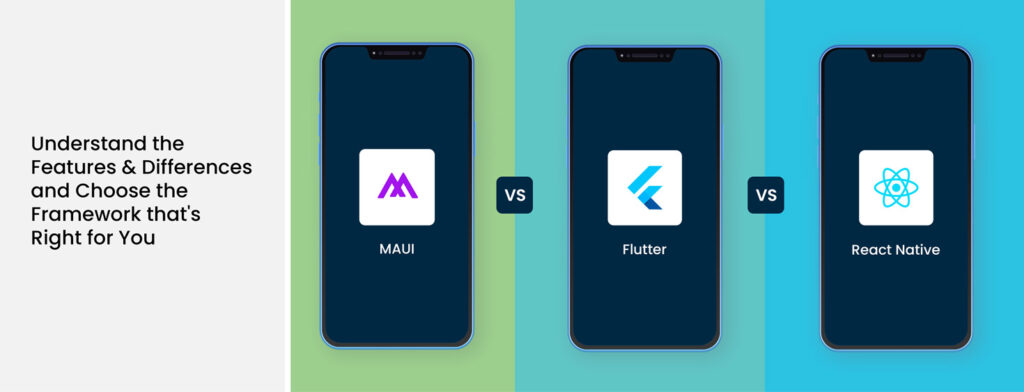In this age of cross-platform mobile app development, choosing the right development framework is critical. Developers and businesses alike need to consider factors such as development speed, performance, platform compatibility, and the overall development experience, to understand which framework would work best for them.
There are three prominent contenders in the cross-platform mobile app development arena – .NET MAUI, Flutter, and React Native. In this article, we’ll delve deeper into each of these frameworks, drawing a comprehensive comparison between them to help you make an informed choice.
A Short Intro to .NET MAUI, Flutter, and React Native
- .NET MAUI (Multi-platform App UI) is an open-source, cross-platform framework developed by Microsoft. It’s an evolution of ‘Xamarin.Forms’ and enables developers to create native mobile apps for Android, iOS, macOS, and Windows from a single codebase using the C# programming language. .NET MAUI also allows developers to target platforms like Android and iOS, macOS, and Windows with a unified API, which simplifies the development process.
- Flutter is an open-source UI framework created by Google. It’s known for its unique “widget” system, where the entire user interface is composed of customizable widgets. Flutter enables developers to create natively compiled applications for mobile, web, and desktop from a single codebase using the Dart programming language.
- React Native is a JavaScript framework developed by Facebook. It allows developers to build mobile applications using JavaScript and React, a popular JavaScript library for building user interfaces. React Native apps are compiled to native code, providing excellent performance and a native look and feel.
.NET MAUI vs. Flutter vs. React Native


| Parameter | |||
|---|---|---|---|
| Development Language and Ecosystem | .NET MAUI uses the C# programming language, which is a widely adopted language known for its strong typing and excellent tooling. It leverages the extensive ecosystem of .NET libraries and packages, offering access to a vast array of resources for developers. Additionally, .NET MAUI integrates seamlessly with Visual Studio and Visual Studio Code, making it a preferred choice for many .NET developers. | Flutter uses the Dart programming language, which may not be as popular as C# or JavaScript. However, Dart is easy to learn for those with prior programming experience and offers a concise and clean syntax. Dart's package ecosystem is growing steadily, and Flutter's plugin system allows developers to access native device features easily. Flutter also offers excellent tooling support, with its IDE called Flutter DevTools and robust support in popular code editors. | React Native utilizes JavaScript, a widely used and highly accessible programming language. JavaScript has a vast ecosystem of libraries and frameworks, making it easy for developers to find solutions to common problems. React Native's support for hot reloading enables rapid development cycles, allowing developers to see changes in real-time, which significantly speeds up development. |
| User Interface | .NET MAUI provides a native-like user interface across different platforms. It uses Xamarin.Forms and the .NET community toolkit to create consistent and platform-specific UI components. This results in apps that feel at home on each target platform. | Flutter's unique widget-based approach allows developers to create highly customized and pixel-perfect user interfaces. It provides a rich set of pre-designed widgets and encourages developers to build their custom widgets. Flutter's UI rendering engine, Skia, ensures high-quality graphics and smooth animations on all platforms. | React Native uses a bridge to communicate between JavaScript code and native components, which can sometimes lead to performance bottlenecks and UI inconsistencies. However, it offers a wide range of third-party libraries and UI components that can help developers achieve a native look and feel. |
| Performance | .NET MAUI leverages platform-specific rendering, resulting in excellent performance on each platform. It also benefits from the performance improvements introduced in .NET 6.0, such as ahead-of-time (AOT) compilation and enhanced runtime performance. | Flutter's performance is impressive, thanks to its use of a compiled language (Dart) and the Skia rendering engine. Flutter apps typically run at 60 frames per second, providing a smooth user experience. | React Native's performance has improved over the years, but it still relies on a bridge to interact with native modules, which can introduce overheads. However, with careful optimization and the use of native modules, developers can achieve good performance in React Native apps. |
| Development Tools and Ecosystem | .NET MAUI offers robust development tools, including Visual Studio and Visual Studio Code support, Xamarin.Forms' extensive ecosystem, and access to the NuGet package manager. The community is growing steadily, and Microsoft provides ample resources for developers. | Flutter has a strong and active community, and Google provides excellent documentation and resources. It has a wide range of plugins and packages available through the pub.dev package manager. Flutter also integrates seamlessly with popular code editors and IDEs, making development smooth and efficient. | React Native boasts of a large and active community, which means a wealth of third-party libraries and plugins are available. It integrates well with popular code editors, and Facebook maintains comprehensive documentation. Tools such as Expo provide an even more streamlined development experience. |
| Platform Support | .NET MAUI supports Android, iOS, macOS, and Windows, making it one of the most versatile cross-platform frameworks available. It also provides support for multiple form factors, including phones, tablets, and desktops. | Flutter supports Android, iOS, web, macOS, and Windows. Its web support is particularly noteworthy, as it allows developers to create progressive web apps (PWAs) in addition to mobile and desktop applications. | React Native primarily targets Android and iOS, but there are community-driven efforts to bring support for other platforms. While it's not as extensive as the other two frameworks, React Native's focus on mobile platforms means it offers a highly specialized experience. |
| Community Support and Long-term Viability | .NET MAUI benefits from Microsoft's support and investment. Microsoft has a strong track record of long-term support for its technologies, which bodes well for the framework's future. | Flutter has gained widespread adoption in a relatively short time, thanks to its backing by Google. Its active community and extensive third-party support indicate a promising future. | React Native has been around for several years and has a large, established community. While Facebook has scaled back its direct involvement, the framework's open-source nature means that the community continues to drive its development. |
| Learning Curve | For developers familiar with C# and .NET, .NET MAUI offers a relatively gentle learning curve. However, those new to C# may require some time to get up to speed with the language and framework. | Flutter's widget-based approach can be both an advantage and a challenge. Developers experienced with declarative UIs may find it easier to learn it, but it might be a bit more challenging for those accustomed to traditional imperative UI development. | React Native's use of JavaScript and React makes it accessible to a broad range of developers. If one is already familiar with JavaScript and React, the transition to React Native is relatively smooth. |
Choosing the Framework that's Right for You
.NET MAUI, Flutter, and React Native — each development framework comes with its own set of advantages and disadvantages. The optimal choice depends on the technical expertise of the developer, the specific objectives and requirements of the project, and the complexity of the application. When venturing into mobile app development, it’s crucial to consider the capabilities of older devices instead of focusing solely on the latest and fastest products in the market.
If you are already proficient in JavaScript, opting for React Native is a straightforward decision. However, if you seek superior performance, stability, and a more unified ecosystem, Flutter is worth considering. Having said that, it’s better to note that Flutter utilizes its rendering engine, which may slightly impact performance in a few scenarios. On the other hand, .NET MAUI leverages native UI components, delivering superior performance on specific platforms. Overall, all three frameworks offer commendable performance, with distinctions that may not be readily discernible in the majority of applications.
Ready to embark on your mobile app development journey? With our extensive expertise in mobile app development and a deep understanding of these frameworks, we are well-equipped to guide you in selecting the optimal path for your project. Reach out to us today!
Author

Muruganandham
Muruganandham is a lead application developer at KANINI in the iOS & MacOS space. His passion for app architecture and innovative mobile applications is very much visible in his collaborative approach, working closely with designers, product owners, and developers to create exceptional user experiences. With 10+ years of experience in app development across GIS, Utility, and Social Media apps, Muru is specialized in combining technical proficiency with a refined UI/UX sensibility.








